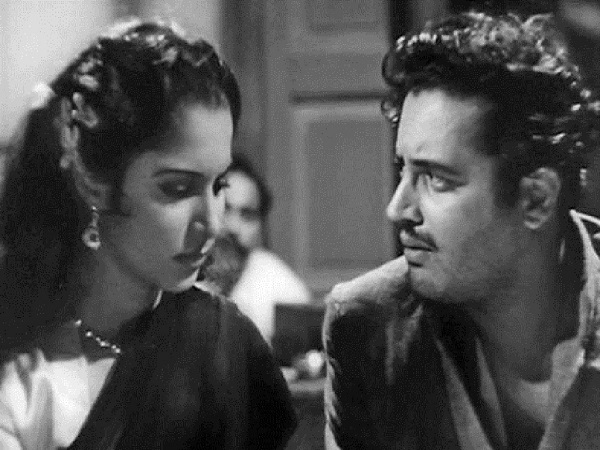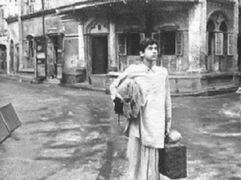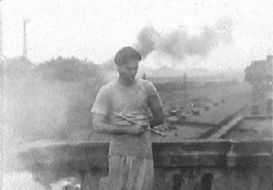GENESIS OF THE INDIAN POPULAR CINEMA The Fifties. The city: paradise and inferno - part one
"Teeming city, city full of dreams" (Baudelaire) "Unreal City... so many. I had not thought death had undone so many" (T.S. Eliot) "Mujh ko yeh narak na chahiye "Yeh mehalon, yeh takhton, yeh tajon ki duniya The fifties are known - and rightly known - as the Golden Age of popular Hindi cinema. They were its high noon. The forties were a prelude, the sixties and later decades a falling away. To do full justice to the structure of the industry in those years, the form and content of the films, the directors, the stars and the artistes who created that achievement, would require many volumes and many authors. In this article, I shall discuss one aspect of the cinema which is largely ignored. Hindi cinema of the fifties was the creation of the post-lndependence burgeoning urban culture. To this day the types and attitudes created in the fifties resonate through the films. This process cannot be discussed here in its entirety. What will be taken up is a tentative study of the complex of processes known as the 'city' as reflected in the cinema. The 'city' as a concept reaching down to our age existed in ancient Greece and earlier. But as the embodiment of a specific culture in its modern form it took shape materially, and in the mind of the artist, in the 19th century. There are many artists whose theme has been the city. For me the really great conceptualisers are Baudelaire, Proust, Fitzgerald, Eliot and Bellow. A flavour of thelr vision is conveyed in the quotations above. In a popular form their mood is reflected in the song quotations from Awaara and Pyaasa. These song-sequences (which are seminal in the history of our cinema) will be discussed later. Here it is enough to refer to the 'dual aspect' of the city in the Awaara quotation - nightmare and dream - and to the rejection of the unreality of the city in the Pyaasa quotation. What is the kind of the city that developed in the post-lndependence period? This question can be answered in two parts: The development of the city in so far as it affected the 'base' - the economy of the cinema industry, and the development of the city as a complex culture which affected the ideology of the cinema artists-creators. As far as the 'base' is concerned, the vast convergence of uprooted masses on the cities had begun during the War in the forties. Here we are concerned particularly with the city of Bombay, the capital of the Hindi film industry. As a centre of political power, as a custodian of cultural values, and as the generator of new ideas Bombay had already played a great role. The leading commercial families of Bombay had transformed themselves into a native industrial bourgeoisie. The affluent class was cosmopolitan, the working class too became increasingly 'mixed'. There was also a highly volatile class of the literate and the unemployed who could find no niche for themselves. As a result, there arouse in the cities a "quality of social restlessness" (Ravinder Kumar, Essays in Social History of Modern India). On the cinema scene descended a large number of directors, actors, producers and distributors from the North as a result of the Partition. The scarcity conditions of the War generated black money which found its way into the film industry. Lack of fresh theatre construction caused by scarcity conditions delivered the 'creators' into the hands of distributors and exhibitors. When distributor/exhibitor became King, the formula film - the film which would get the quickest returns from a volatile and rootless audience - became the sovereign popular art form. It's the fashion today to abuse the formula film. It was a product of material circumstances. But even a formula film could succeed only if it made innovations. The dream factory had to show a measure of originality because it really was not an assembly line. It's the tension between the need for a quick return formula and the need for innovation that produced the Golden Age. Ideology crept in between the interstices of the complex web created by the tension (this primarily refers to the geniuses of the Golden Age - Bimal Roy, Raj Kapoor, Guru Dutt). It is this fact that is responsible for the abnormal and dissonant elements which fissure the fabric of realism in Awaara and Pyaasa. For artists like Bimal Roy, Raj Kapoor and Guru Dutt, the 'city' of the fifties offered a rich tapestry There was no significant break with the impoverishment of the past; westernisation which was synonymous with modernisation permeated only the upper and middle classes; there was anonymity, impersonality and segmentation of roles; there was high social mobility and heightened individualism; there was a balance between the bazaar and capitalistic system of production; there were squatter settlements which survived as creative and functional economies under conditions of abject poverty - pawn-broking, bribery, petty thefts, prostitution, black market and a host of illicit activities connected the legitimatel formal and illegitimatelinformal sectors. (M.A. Qadeer, Urban Development in the Third World). In short, the city was a kaleidoscope (Mrinal Sen actually used this title for one of his recent films) which showed development favouring the rich and the poor becoming powerless because they were bound to the rich myriad ways. Bombay and Calcutta have great similarities, vast differences. In Calcutta the dominant social class in the city in the 19th century was the East India Company bureaucracy, and their descendants today - the government and private sector senior employees - are still important. Then there was (in the l9th century) the native world of territorial magnates (Rajas), landed gentry (Zamindars) and the professionals. Then again, there were the upcountry Marwaris who picked up the business ignored by the British. These trends or their successors are very much there today - made more complex by the decline of the Calcutta industry and the peculiar process of the interaction between the affluent and the unorganised. All these facets are there in the films of Satyajit Ray, who created the cinematic city and to whom at least Guru Dutt owes a debt. Ghatak and Mrinal Sen too are important in this context but for reasons of space I shall restrict myself to Ray.
Apur Sansar involves both celebration and rejection of the city. The celebration comes in the early sequences when Apu (in Pulu's company) bursts forth into a song in the railway yard (Tagore's Basundhara) - "Let me burst open the heart's narrow cage / Break down the hard stone walls / The dark and cheerless prison of my mind". There's talk of Goethe, Dickens, Keats, Lawrence, Dostoevsky. And, Apu, in a burst of youthful exuberance, makes a significant statement: "A village boy... poor, but sensitive... Father's a priest. He dies... The boy comes to the city. He will not be a priest. He will study. He's ambitious. Through his education, his hardships, we see him shedding his old superstitions, his orthodoxy. He must use his intellect. He cannot accept anything blindly. But he has imagination, he's sensitive. Little things move him, give him joy. He may have in him the seeds of greatness, but.... he does nothing great. He remains poor, in want. But in spite of that he never turns away from life... He wants to live". (Apu Trilogy - English version by Shampa Banerjee).
That sequence has a central importance in the Apu trilogy. When I think of that sequence I ask myself: How can these two young men be so ebullient, so euphoric amidst the bleakness of that railway yard, symbolic of the ultimate blight of an urban industrial culture? It's the city - or rather the finest products of the city - Tagore, Dostoevsky et al - ! who have made Apu and Pulu transcend urban bleakness. 'Transcend' - not in a spiritual or escapist sense - but of achievement of a certain 'overarching eye' which can look at the city and one's self in relation to it without self-pity or romanticism. This is the greatest gift of city life. Ray does not idealise the city. Apu's room on the terrace overlooks the railway yard, the pigs, the slum, and the coal bins. Aparna sobs when she first looks out of the window, recoils at the cockroaches. She gets 'used' to the City, but she dies before she is 'used up'. When Apu contemplates suicide, what deflects him is the pig's death on the tracks (compare it with the sequence of the death on the tracks in Pyaasa). That scene is open to many interpretations. To me it covers the casually indifferent inhumanity of the city. Apu deserts the city. In a final rejection of 'city ambitions', he throws away the novel. At the end, there's a chance that he may return to Calcutta because his son is there. Ray hasn't really explored the city in Apur Sansar. He seems to be reflecting about it, not fully prepared to work out the inner logic of urban dehumanisation. Modern Calcutta furnished the background to Mahanagar, Nayak and a kind of backdrop to Aranyer Din Ratri. But it's another 'trilogy', Seemabadha, Pratidwandi and Jana Aranya, that's about the 'city as city' - meaning that it reflects about the city, its compulsions and its victims. Chidananda Das Gupta has some very important things to say about Jana Aranya: "For the first time Calcutta comes to life. Its grime and dirt are established with the very first shot... Jana Aranya epitomises... the failure of earlier values celebrated... Pauline Kael shrewdly compared Ashim in Aranyer Din Ratri to a corrupted Apu; indeed all urban heroes in Ray's contemporary films are - Siddhartha in Pratidwandi, Shyamalendu in Seemabadha; Somnath in Jana Aranya in their different ways... No film of Ray has an equal sense of the complexity and depth of evil as Jana Aranya". I admit the force of Gupta's reasoning but would like to take the argument further. Ray has always had a wary attitude to city and urban success - the message on this point in Mahanagar and Nayak is clear. But in the new trilogy Ray comes to grips with the 'internal dynamics' (Dr. M.A. Qadeer) of the city. To call it 'evil' is perfectly justified. But one must also appreciate the art which weaves the links, the specific culture, the socio-economic drives in a pattern of such ruthless inevitability, that no 'choice' - in the day-to-day living, not in a philosophical sense - is left. And without choice, moral judgement will have to evolve a much more complex concept than 'evil'. In Pratidwandi there is a direct ideological defeat for the hero. He is beaten by the drive of urban culture. In Seemabadha it is the dependent urbanism - dependent on the finance and lifestyle of developed countries - that beats him. In Jana Aranya it's the sheer pressure of the crowd the struggle for survival that gets the young man down. Jana Aranya is the most sophisticated examination yet of the'essence' of an Indian city. It shows as no other film has done, why, in our cities, poverty, inequality and public ineffectiveness persist despite remarkable industrial development. Jana Aranya also shows how the sectors complement each other, how the supply of girls to a managing direcot is an essential link between the organised/formal and unorganised/informal sectors in an Indian city. That's why the most vital figure in Jana Aranya is neither the bewildered and compliant Somnath or his moral tradition-bound father, but Mr. Natabar Mitter, the PRO-pimp. For the same reason I cannot regard Somnath as a 'corrupted Apu'. The world of Apu is aeons away from the world of Somnath. Apu could be a relatively free agent. Somnath is condemned to be a child of the city of his time - a dupe and a tool. The cities of both Apu and Somnath bear a common name but as Baudelaire says: "The form of a city, alas, changes more quickly than a mortal's heart". What really sets apart Somnath from Apu is sadness about what was and lack of hope for what is to come.
Iqbal Masud Film citati nell'articolo (regista, anno, lingua): A cura di |



